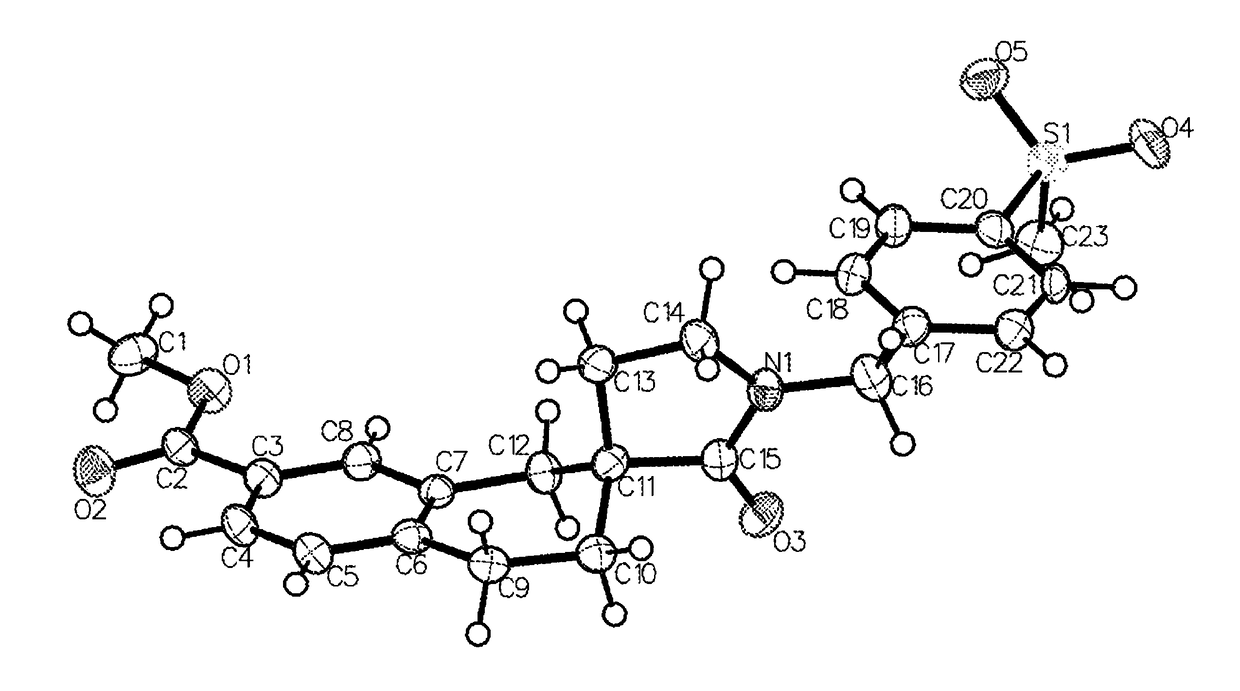3-spirocyclic-6-hydroxamic acid tetralins as HDAC inhibitors
a technology of hdac inhibitors and tetralins, which is applied in the direction of nervous disorders, drug compositions, organic chemistry, etc., can solve the problems of limited effectiveness and unwanted side effects
- Summary
- Abstract
- Description
- Claims
- Application Information
AI Technical Summary
Benefits of technology
Problems solved by technology
Method used
Image
Examples
example 1
Preparation of N-hydroxy-2′-oxo-1′-phenyl-3,4-dihydro-1H-spiro[naphthalene-2,3′-pyrrolidine]-7-carboxamide (I-26)
[0378]
Step-1: Naphthalene-2,7-diyl bis(trifluoromethanesulfonate)
[0379]Into a 1-L round-bottom flask was placed naphthalene-2,7-diol (60 g, 374.6 mmol, 1equiv) in THF (600 mL), trifluoromethanesulfonic anhydride (127 g, 1.2 equiv) and 2,6-dichloropyridine (250 mL). The resulting solution was stirred overnight at room temperature and then concentrated under vacuum. The residue was diluted with 500 mL of EtOAc, washed with 5×100 mL of water and concentrated under vacuum to give 120 g (75% yield) of the title compound as a yellow solid. MS: (ES, m / z): 425 [M+H]+.
Step-2: Dimethyl naphthalene-2,7-dicarboxylate
[0380]Into a 1-L round-bottom flask was placed naphthalene-2,7-diyl bis(trifluoromethanesulfonate) (80 g, 188.55 mmol, 1 equiv) in MeOH (600 mL), Pd(dppf)Cl2 (6g, 8.20 mmol, 0.04 equiv) and Et3N (79 mL, 3 equiv). The resulting mixture was stirred overnight at 70° C. under...
example 2
Preparation of 1′-(3,4-dichlorobenzyl)-N-hydroxy-2′-oxo-3,4-dihydro-1H-spiro[naphthalene-2,3′-pyrrolidine]-7-carboxamide (I-21)
[0387]
Step-1: Methyl 1′-(3,4-dichlorobenzyl)-2′-oxo-3,4-dihydro-1H-spiro[naphthalene-2,3′-pyrrolidine]-7-carboxylate
[0388]Into a 25-mL round-bottom flask was placed methyl 2′-oxo-3,4-dihydro-1H-spiro[naphthalene-2,3′-pyrrolidine]-7-carboxylate (150 mg, 0.58 mmol, 1 equiv) in DMF (5 mL), NaH (60% dispersion in oil, 42 mg, 1.75 mmol, 3 equiv) and 4-(bromomethyl)-1,2-dichlorobenzene (208 mg, 0.87 mmol, 1.5 equiv). The resulting mixture was stirred for 1 h at room temperature. The reaction was then quenched by the addition of 20 mL of water. The resulting solution was extracted with 3×50 mL of EtOAc. The organic layers were combined and concentrated under vacuum to give 190 mg (79% yield) of the title compound as a colorless oil. MS: (ES, m / z): 418 [M+H]+.
Step-2: 1′-(3,4-Dichlorobenzyl)-N-hydroxy-2′-oxo-3,4-dihydro-1H-spiro[naphthalene-2,3′-pyrrolidine]-7-carbox...
example 3
Preparation of N-hydroxy-2′-oxo-1′-(pyridin-4-yl)-3,4-dihydro-1H-spiro[naphthalene-2,3′-pyrrolidine]-7-carboxamide (I-30)
[0391]
Step-1: Methyl 2′-oxo-1′-(pyridin-4-yl)-3,4-dihydro-1H-spiro[naphthalene-2,3′-pyrrolidine]-7-carboxylate
[0392]Into a 100-mL round-bottom flask was placed methyl 2′-oxo-3,4-dihydro-1H-spiro[naphthalene-2,3′-pyrrolidine]-7-carboxylate (100 mg, 0.39 mmol, 1 equiv) in 1,4-dioxane (5 mL), 4-bromopyridine hydrochloride (73 mg, 0.38 mmol, 0.97 equiv), Pd(OAc)2 (8.5 mg, 0.04mmol, 0.1 equiv), XantPhos (70 mg, 0.12 mmol, 0.3 equiv) and Cs2CO3 (190 mg, 0.58 mmol, 1.5equiv). The resulting mixture was stirred overnight at 101° C. The solids were filtered out. The filtrate was concentrated and purified by normal phase chromatography on silica gel with EtOAc / petroleum ether (2:1). The collected fractions were concentrated to give 90 mg (69% yield) of the title compound as a solid. MS: (ES, m / z): 337 [M+H]+.
Step-2: N-Hydroxy-2′-oxo-1′-(pyridin-4-yl)-3,4-dihydro-1H-spiro[nap...
PUM
 Login to View More
Login to View More Abstract
Description
Claims
Application Information
 Login to View More
Login to View More - R&D
- Intellectual Property
- Life Sciences
- Materials
- Tech Scout
- Unparalleled Data Quality
- Higher Quality Content
- 60% Fewer Hallucinations
Browse by: Latest US Patents, China's latest patents, Technical Efficacy Thesaurus, Application Domain, Technology Topic, Popular Technical Reports.
© 2025 PatSnap. All rights reserved.Legal|Privacy policy|Modern Slavery Act Transparency Statement|Sitemap|About US| Contact US: help@patsnap.com



